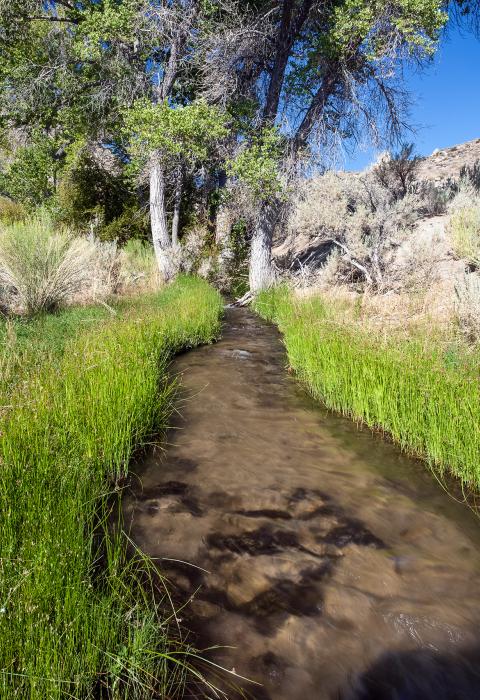Cottonwood Creek
California
Cottonwood Creek originates in ancient bristlecone forests and is the longest perennial stream east of the White Mountains. The creek flows eastward from the 14,000-foot crest of the White Mountains and steeply descends through groves of aspen, eventually flowing into a sagebrush desert. Numerous springs feed the creek as it meanders through large meadows in the upper reaches. Stands of aspen and bristlecone pine can be found in the higher elevations, while lower elevations are marked with stands of pinyon and juniper trees.
Designated Reach
March 30, 2009. From its headwaters at the spring in Section 27, Township 4 South, Range 34 East to the northern boundary of Section 5, Township 4 South, Range 34 East.
Outstandingly Remarkable Values
Culture
Cottonwood Creek and Canyon (known as tō’sa kwā’ si wü’ha to the Paiute) was a Paiute/Shoshone trail corridor connecting the high elevation resources of the White Mountains to the lower elevation resources of Fish Lake Valley. Cultural resource sites along the river corridor represent temporary seasonal habitation locales and were probably selected due to their proximity to water, plant, and animal products. Sites located along the river corridor consist of lithic scatters with milling features, house rings, rock shelters, and rock art panels. Twelve prehistoric sites have been documented in the corridor to date and are eligible for listing in the National Register.
Cottonwood Creek also has a long history of grazing and mining resources that are significant at the local level. The Eva Belle Mine was owned by the Minerals Management Company of Dyer, Nevada, and a former log cabin associated with the mining company remains at the site. It was a prosperous gold mine that was also a source of silver, copper, lead, and zinc. Smaller-scale resources associated with grazing and mining include rock-lined dugout features, fences and corral features, and arborglyphs (carvings of shapes and symbols into living trees) in aspen groves along the river corridor. These historic-era ethnographic features and mining sites may be eligible for listing in the National Register of Historic Places.
Fish
Paiute cutthroat trout were introduced to Cottonwood Creek in 1946 by a transplant from the Silver King Creek Basin, and descendants of that transplant survive in the creek today and have formed a self-sustaining population, one of five in existence. The population is found upstream of the confluence with Tres Plumas Creek where a natural barrier prevents non-native trout from migrating upstream. Pools are important rearing habitat for juveniles and act as refuge areas during winter.
Scenery
Outstanding features include a bristlecone pine forest, scattered areas of rocky outcrops, aspen groves, sagebrush, meadow, and narrow canyon. The approach to the headwaters area provides an overview of the corridor before dropping into Cottonwood Basin for a closer view. The diverse components of the landscape provide an abundance of color and patterns, and summer and fall are particularly distinct due to extensive wildflower blooms, aspen groves, and golden meadows contrasted with pine forest on hillsides and ridges.
Wildlife
Wildlife supported by the unique plant community include a number of special status and/or sensitive bird species, such as yellow warbler, yellow-breasted chat, prairie falcon, sharp-shinned and Cooper's hawks, and the basin is potentially suitable habitat for the southwestern willow flycatcher, a federally endangered species. This segment of Cottonwood Creek supports over 70 species of birds. The lower segment of Cottonwood Creek is also an important habitat for the spotted bat, which is a federal and California state special concern species. Paiute cutthroat trout, a federally threatened species, inhabit the north fork of Cottonwood Creek in the Inyo National Forest.
Botany
Forest Service sensitive/SCC plants known to be in Cottonwood Creek include trianglelobe moonwort, scalloped moonwort, western singlespike sedge, valley sedge, Hall’s hawksbeard, male fern, Poison Canyon stickseed, blue nodding locoweed, Rolland’s bulrush, and Dedecker’s clover. There is a high number and density of rare plant species present, and there is high potential for additional, unknown occurrences of Forest Service sensitive plant species within the river corridor. Cottonwood Creek supports a lush riparian community and riparian habitats include wet and moist meadows, aspen forests, willow shrub communities, and cottonwood forests at the lowest elevations. Unglaciated meadows, a special habitat type in the Inyo National Forest Terrestrial Ecological Unit Inventory dataset, are present in the upper reaches of the river corridor. While the river is small in size, it is one of the few unique riparian areas in an otherwise harsh desert mountain landscape.

